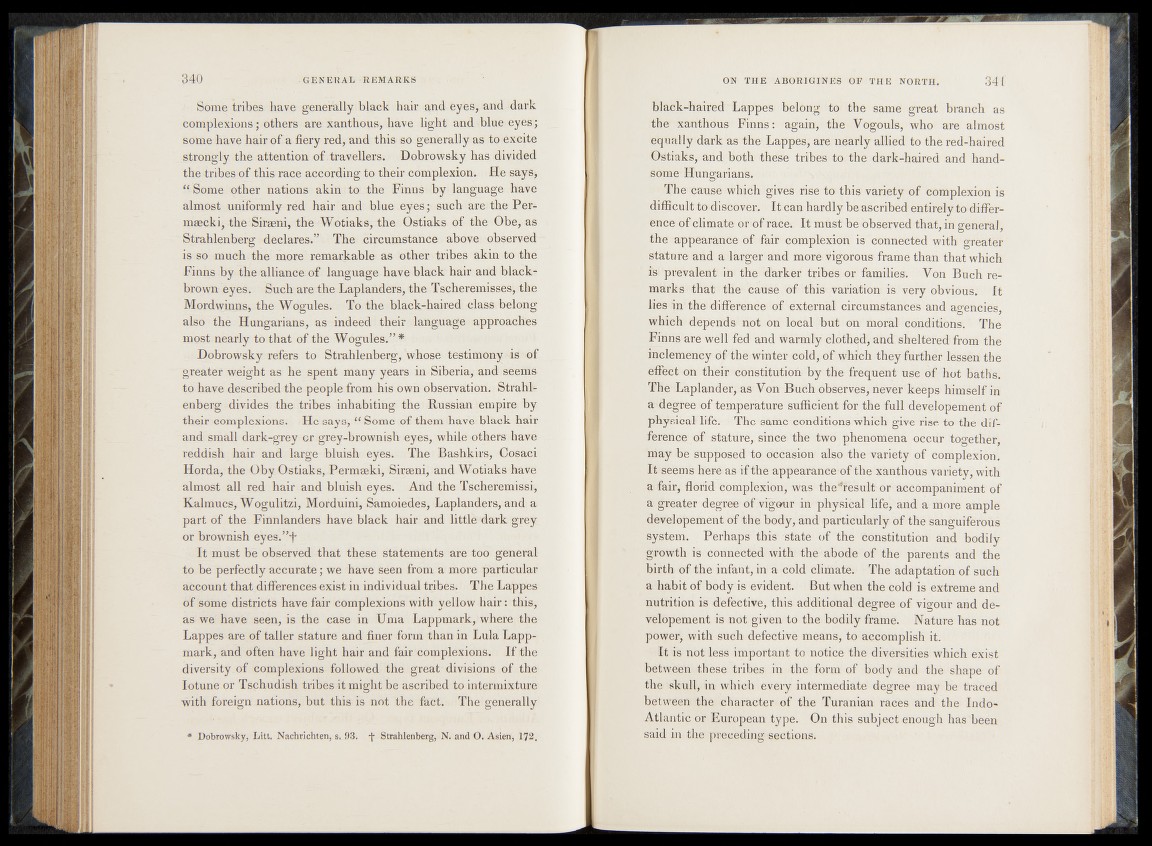
• Some tribes have generally , black hair and eyes, and dark
complexions; others a reian tb o u s,h av e light andbluereyest;
some have hair o fa fiery red, and this so generall y as to Excite
strongly the attention of travellers. Dobrowsky has divided
the bribes of this race according to their complexion. He says*
“ Some other nations akin to the Finns «by language have
almost uniformly red hair and blue .eyes ;• such are the Bet*
msecki, the Sir8Bni, the Wotiaks, the Ostiaks of the Qbe, as
Strahlenberg declares.” The : circumstance above observed'
is so much the more remarkable as other tribes akin to the
Finns by the alliance of language have black hair and Mack?
Mown eyes. Such are the Laplanders, the Tscheremisses^ the
Mordwiuns, the Wogules;-? To the black-haired; class: belong
also thé Hungarians, as indeed ? their language; approaches
most nearly to that of the Wogules.” *
Dobrowsky refers to Strahlenberg, whose testimonyAks^-of
“greater weight as he spent many years imSiberi^iänd *sèerÖs
to have described the people from his own observation;; Strahl*-
enberg divides the tribes inhabiting the Russian empire- by
their complexions. He says, “ Some of them have?Black-hair
and small dark-grey or grey-brownish^eyès,, whilc othersdiave
reddish hair and large bluish eyes; . The Bashkirs, 'Oosacsi
Horda, the Oby Ostiaks, Permseki, Sirseni, aaadcWotiaks have
almost all red hair and bluish eyes. And the Tseheremissi£
Kalmucs, Wogulitzi, Morduini, Samoiedes, Laplanders, and a;
part of the Finnländers have black hair and little dark gvßfi
or brownish eyes.
It must be observed that these, statements are too general
to be perfectly accurate; we have seen from a more particular
account that.differencesexist in individual tribes. The Lappes
óf some districts have fair complexions with yellow h air: this,
as we' have seen, is the case in Uma Lappmark, where (the
Lappes are of taller stature and finer form than in Lula Lappmark,
and often have light hair and fair complexions. If fhe
diversity.of complexions followed the great'divisions of the
Iotune or Tschudish tribes it might be ascribed to intermixture
with foreign nations, but this is not the fact. The generally
* Dobrowsky, Litt. Nachrichten, g, 93, -f- Strahlenberg, N, and O. Asien, 172,
black-haired Lappes belong to the same great branch as
:t*be’ xanthous Finns: againj the Vögouls, who are almost
eijuaMy dark as the Lappes, are nearly allied to the red-haired
Ostiaks, and both these tribes to the dark-haired and handsome
Hungarians.
‘u* The-cause whidhOgives rise to this variety of complexion is
difficult toSdisboi#ei|#dt can hardly be ascribed entirely to difference
o f climate ©tfróf rdêe; It müstbe observed that, in general,
the appearance of fair complexion is “connected with greater
staf are and a larger and moré vigorous frame than that which
‘prevalent in the darker tribes:,or families. Von Buch re^-
mërktsihht the^CSÖe of this variation is'very obvious. It
lies-4n* the’difference-mf external" circumstance's and agencies,
which depends^ not on local-but on 'moral conditions: The
F in n s^ têw ^ 'ffi^ a n d warmly clothed", and sheltered from the
inclemency bfi4he winter eold, of which they further lessen the.
effect on their constitution by the frequent uêélóf hot baths.
The Laplander; as Von Buch observes, never keeps hinfsdf m
a Ségree of temperature sufficient for the full ‘developement of
physical life. The sameioonditions which |cive rise to the difference
JoF** stature, sincedthe two phenomena occur together,
may Ibfe’supposed to'occasion also the variety of complexion:
I tfseems h'ereias. ifthe appearance *of the xanthous variety, with
a*fair, florid complexion, was the^esult or accompaniment of
ac greater degree óf vigour in physical life, and a more ample
developemenfc of thehody, and particularly of the sanguiferous
system. Perhaps this state of the Constitution and bodily
growth is connected with the abode of the parents and the
birth of the infant, in a cold climate;- The adaptation of such
a habit o f body is evident. But when the cold is extreme and
nutrition is defective, this additional degree of vigour and de-
vélópement is not given to the bodily frame. Nature has not
power; with such defective means, to accomplish it.
It ik not dess important to notice the diversities which exist
bétwèb'n these tribes- in the form of body land the shape of
the skull, in which every intermediate degree may be traced
between the character of the Turanian races and the Indo-
Atlantic oj European type. On this subject enough has "been
said in the precedingcsections.